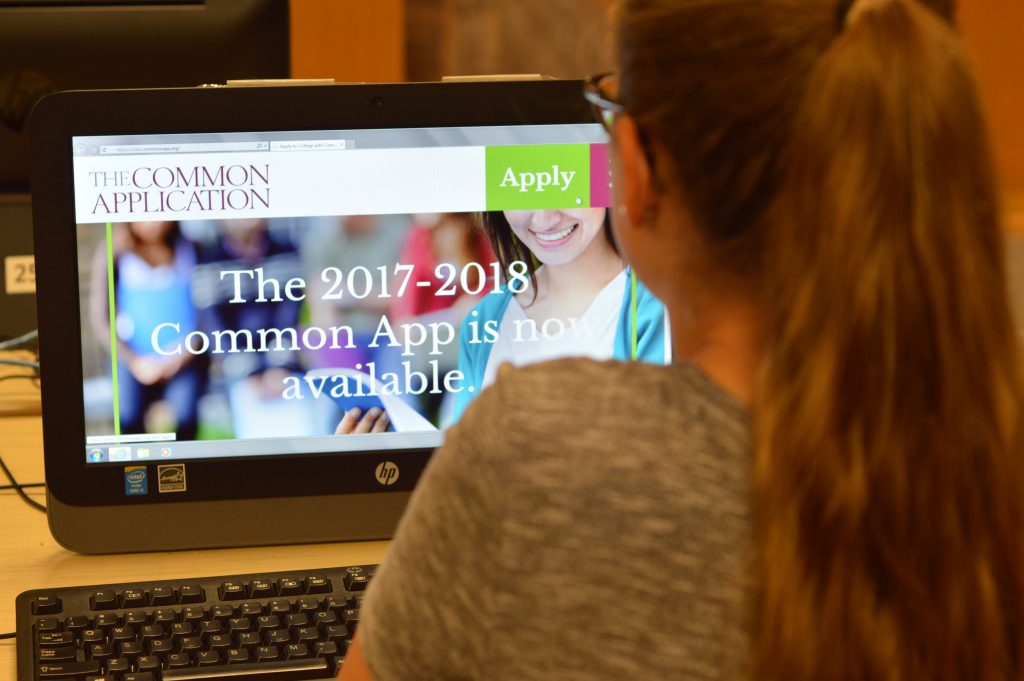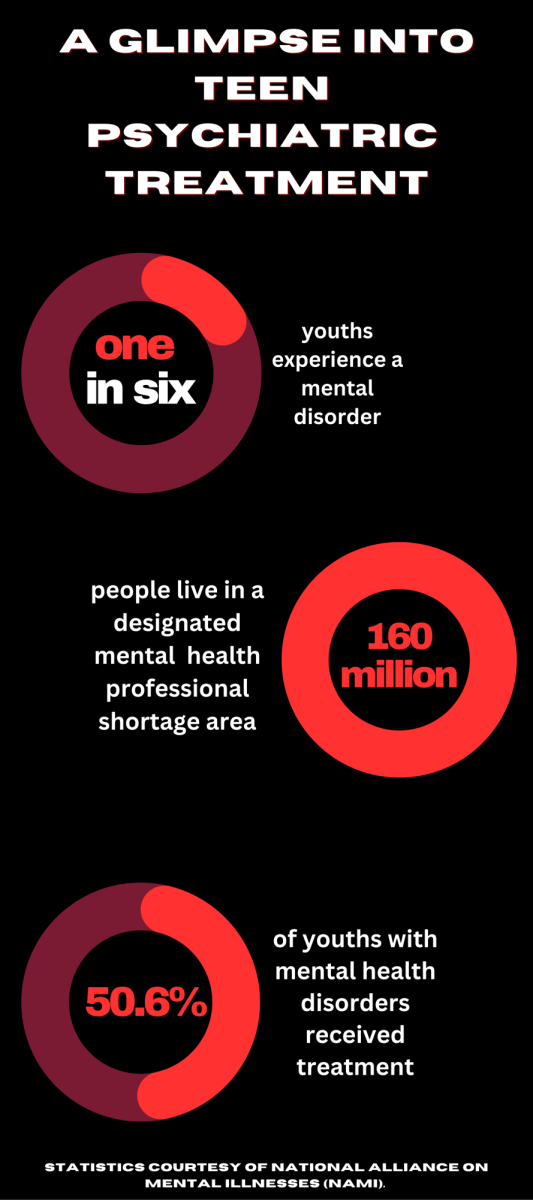Standardized tests. Supplemental essays. Stress.
According to the National Center for Educational Statistics, estimated college enrollment has increased from about 15.3 million in 2000 to an estimated 20.4 million in 2017. But every college bound senior experiences a different application process.
Some know exactly what path they want to take, while others won’t know the university they attend until they pay their deposit fee on May 1, National Decision Day.
ΔΔΔ
When it comes to the college process, senior Cindy He says she feels lost.
He says she worries that applying undecided could hurt her chances of admission, so instead she’s checking off nursing as her intended major. She also has until Nov. 1 to apply to a school early decision but is having trouble choosing between several universities– Penn, Johns Hopkins and Carnegie Mellon.
So, He is working on supplemental essays for all three schools and waiting to decide where she wants to submit an application. But she says the pressure of the November deadline is quickly mounting. Now, she has to spend most of her time on weekends working on applications and editing essays with her parents.
“I would say I should have done more things by now than I have already,” He said. “I haven’t gone outside of my house on the weekends in a very long time. I feel like a hermit.”
Applying early decision to a college is similar to signing a business contract. The applicant agrees to only apply early to one school, and, if accepted and awarded an adequate financial package, they must attend the university and withdraw any regular decision applications. Also, the applicant could be rejected or deferred, meaning their materials will be considered again during the regular decision process.
The more than 200 colleges in the U.S. that offer early decision admission typically advertise it as a way for students to demonstrate interest and show that the school is their first choice. But because a number of top-tier schools boast higher acceptance rates for early decision applicants, students like He see it as a strategic move to boost their chances of getting in. For instance, while about 7 percent of regular decision applicants were admitted to Penn last year, 22 percent of early decision applicants made the cut, according to Top Tier Admissions.
Another perk for early decision candidates like He is the faster decision date. While many regular decision schools send their acceptances and rejections out in late March or early April, early decision candidates typically learn their fate in mid-December. If He does get rejected or deferred by her early decision school, she says she’ll need to work on regular decision applications during winter break and send them out before the typical January deadline.
He says the idea of going to college was always in the back of her mind. At a piano lesson when she was five-years-old she remembers her mother telling her that, if she practiced enough, she could earn a scholarship one day.
In freshman year, He joined her family on various college tours for her brother, Zooey, who is now a sophomore at Johns Hopkins. And starting in junior year, she visited at least 12 schools that she was interested in applying to like Penn, Yale, Swarthmore and Cornell. But after these tours, He says she never fell in love with a particular school.
“Some people get that feeling where they’re like ‘this school really speaks to me,’ but I’ve never really gotten that feeling,” He says. “I’ve also never gotten the feeling of ‘oh I hate this school.’ So I feel like I would be okay anywhere, but I guess no one really knows until you go.”
Right now, He says she is most worried about finishing various essays for her applications. She has thrown around a number of topics from her passion for music to her commitment to the girls’ tennis team, but she says she’s had trouble crafting an essay both she and her parents believe is good enough. Because the essay is the one part of her application she can still fix, He says she feels more pressure to make it perfect.
“What your grades were in sophomore or junior year, you can’t really change that anymore,” He says. “But the essay is what you still can control, and it’s the last thing you can do to get the best application you can.”
ΔΔΔ
Senior Hunter Krauss had to plan his future much earlier than He.
In ninth grade, Krauss started his college search when Dartmouth contacted him about playing Division 1 lacrosse at their school. After that, he was approached by schools like Lafayette, High Point University and the University of Hartford, where he verbally committed last August.
Krauss says his visit to Hartford stood out from the other schools, where he met with the coach, went on a tour and then had a discussion with the coach about possible offers. At Hartford, he says being able to eat dinner and stay with some of the players helped him feel more comfortable with the campus and team. After the visit, the coaches made him an offer and within a few weeks, Krauss accepted.
“I feel like they really welcomed me in with open arms,” Krauss says. “I always heard coming up, my coaches were saying ‘once you walk on campus you’ll know.’ I hadn’t really gotten that feeling yet, and I wasn’t sure if I necessarily believed that. But when I was at Hartford, I just felt comfortable, and I knew ‘hey this is the place I want to go’ within the first 20 minutes I was there.”
Before looking at schools, Krauss had to decide his future major and career as a freshman. Krauss chose to major in either biology or go into a pre-dental program to eventually become an orthodontist, and if a school didn’t offer these programs, he crossed them off his list.
“It was hard to think about like ‘what do I want to do when I get to college and outside of college’ as a freshman in high school,” Krauss says. “I had to really think about all the different programs, what classes I did like freshman year and what I wanted to pursue and talk to my parents about what they thought would be best.”
Krauss has an older brother who attends Notre Dame on an academic scholarship, but his family had never been through the college recruiting process beforehand. Outside of the high school team, Krauss plays for The Dukes Lacrosse Club in Philadelphia, a club team focused on helping students be recruited by colleges. Rather than practicing to win games, the team travels to tournaments in hopes of being noticed by college coaches in the stands.
The coaches at Dukes helped Krauss contact recruiters from colleges who were interested in him. Once he started receiving offers from schools, they also assisted him in negotiating scholarship offers with various universities. He says his coaches encouraged him to ask for more financial support if he had an interest in attending and affording the school.
“If I wanted to go to that school or get a certain amount of money from that school I had to do that,” Krauss says. “It felt awkward, but it happens a lot, so it’s not like the coaches look down upon you for doing that stuff.”
Once Krauss verbally committed to Hartford, he says he was able to relax. And, when he submits his application and signs his National Letter of Intent next month, he’ll officially be done with the college process.
“It was a huge weight off my shoulders just because it was a long process,” Krauss says. “The first two years of high school were pretty stressful. But it was definitely less stressful for these past two years, when a lot of kids are stressing to figure out what they want to do and stuff like that.”
ΔΔΔ
After a field trip with her accounting class in sophomore year, senior Carly Valdivia knew she wanted to attend Temple University.
“I liked the size of the campus because I just love big schools,” Valdivia says. “I met with a lot of the people that were in the accounting program there, and I talked with a lot of people who taught in the accounting program there because I was there for an event, and I just really liked it.”
Originally, Valdivia researched schools and created a list of about 16 colleges she would consider attending, but after narrowing down her options, she submitted applications for seven universities in late September. Valdivia says she chose where she wanted to apply based on cost and the ranking of the school’s business program.
She applied to in-state institutions like Kutztown University, Indiana University of Pennsylvania, Bloomsburg University and Temple to keep costs lower. She also decided to keep various out-of-state schools like Hofstra University, Pace University and Rutgers on her list because she heard they tend to offer generous financial aid packages. Valdivia also applied early action to any schools that offered the plan, including Hofstra, Pace and Temple.
Like early decision, students applying early action typically submit their materials by Nov. 1 and receive their admission decision between December and January. But, students can apply to more than one college through early action, and if they are accepted they still have until May 1 to choose what university they will attend.
Additionally, some schools that Valdivia applied to, like Kutztown and Bloomsberg, offer rolling admission, which means the admissions committee reviews students’ applications as they receive them. About two weeks after she sent her application materials to Kutztown and Bloomsberg, Valdivia learned she had been accepted.
“I wasn’t expecting to get it back that early at all, but it’s nice to know that and get it out of the way,” Valdivia says. “It’s nice knowing that I’m into some of my schools that I’m applying to, especially because my parents are just happy that I’m going [to college.]”
While Valdivia says her parents are supportive of her decision to attend college, she has had to fill out her applications on her own. Valdivia’s parents immigrated to the United States from Bolivia in the early ‘90s. Her father never went to college and her mother earned an education degree in Bolivia, and Valdivia says both of them have limited knowledge of the college process.
“I actually didn’t get help from any of my family at all because they have no idea what to do with it,” Valdivia says. “They gave me some advice here and there. Honestly, they’re just happy that I want to go to college and that I’m motivated to go.”
When Valdivia had questions about her applications, she met with her guidance counselor and asked for help. In general, she says she had few problems with the application process.
So far, Valdivia says waiting for her admissions decisions has been difficult, and she worries about the parts of her application she can no longer edit.
“It stressed me out, not while I was doing the applications, because I had everything prepared,” Valdivia says, “just after I submitted them I was like ‘oh my God’ because I can’t really go back and change anything. I submitted everything, so it was kind of nerve-wracking.”






